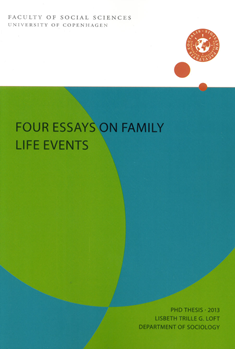Four Essays on Family Life Events
Lisbeth Trille Gylling Lofts thesis consists of four articles, an introduction chapter and a chapter about the Danish contexts.
How individual, social, and institutional contexts shape family life events
As demographic and social trends continue to change the institution of the family, a need to reconsider the study family life events as they unfold over the life course has emerged. The present thesis investigates the way in which individual, social, and institutional contexts shape family life events.
 The importance of children’s characteristics
The importance of children’s characteristics
The first analytical chapter investigates the importance of children’s health in parental relationship termination and in parent’s subsequent childbearing. Findings suggest that, as found in other national settings, health-related disparities in family-level outcomes are also present in the Danish context.
Danish children experiencing disability or long-term illness remain at a higher risk to also grow up in a single-parent household and to have a less dense sibling-based kin network to rely on when the parents are gone.
Furthermore, these two studies demonstrate that child characteristics play a substantive role in family life. Thus, to only question family life events as a function of parental characteristics neglects an understanding of the importance of the dynamic link between the lives of children and their parents in contemporary families.
The need to link family contexts and institutional settings
The second analytical chapter introduces a new concept called care capital, and empirically applies it to mothers’ employment transitions surrounding childbirth in the American setting. The aim of this study is to integrate perspectives from sociology and social demography in order to develop a concept that can encompass the variety of care indicators, can draw attention to excluded care variables, and can provide a framework for future individual and comparative research.
Results from this study indicate that the use of non-parental child care prior to employment is independently and positively associated with the time to mothers’ labor force entry following the birth of a child in the American context. Although the development of the concept of care capital is in its early stages, this study establishes the usefulness of conceptually grouping factors related to care as a compliment to economic and human capital.
The significance of the interconnectedness of family life events across life domains and over time
The third analytical chapter examines the interplay of changes in societal opportunity structures and individual patterns of family formation. The purpose of this chapter is to provide a renewed framework for understanding family formation behavior.
As opposed to studying only one family-related life course transition at a time, this analysis highlights the benefits of understanding family life events through their interconnectedness with events in other life domains.
This study identifies typical family formation pathways, and shows that the sorting into each of these is dependent on personal preferences, individual abilities, socio-demographic factors, and gender. This study underscores that in order to sufficiently understand family life behavior, attention to the simultaneous presence (or absence) of multiple social roles, their timing, and their sequence is of fundamental importance.
Contributions
Taken together the analyses included in the present thesis combine the need to understand conditions and consequences of contemporary family life with a renewed attention to the mechanisms associated with social differentiation.
One contribution of the present thesis is that it highlights the need for family research in general, and Danish family studies in particular, to pay greater theoretical and methodological attention to the dynamic nature of family life events.
In addition, the present thesis underlines the need for an improved understanding of the role of health and caregiving as fundamental aspects of family life, and in doing so allocates increased attention to how children’s characteristics are central to family-level outcomes.
Just as the lives of family members are lived interdependently, so too are events in one life domain interconnected with the absence or presence of events and transitions in other life domains. Thus, in order advance knowledge on family life and behavior, multiple family life events must be considered simultaneously, in a dynamic framework, and over time.
